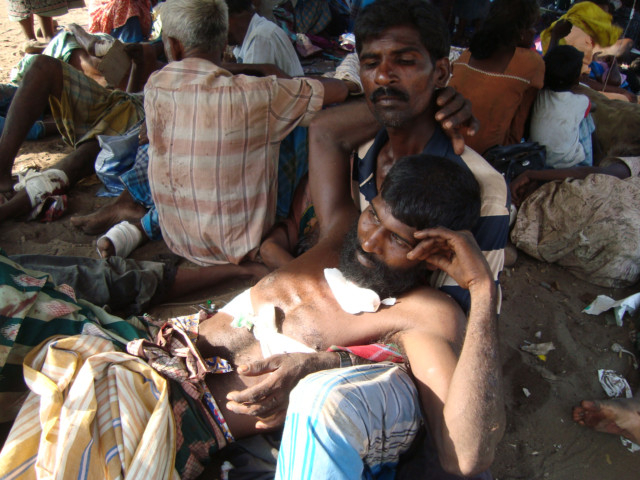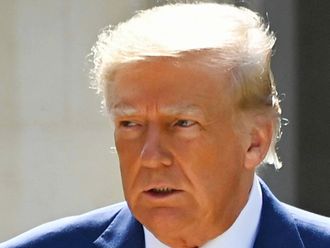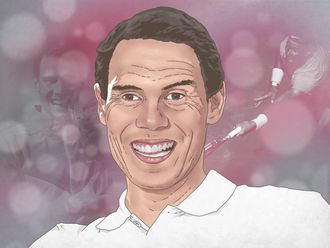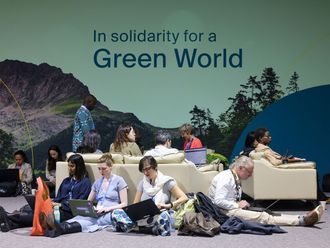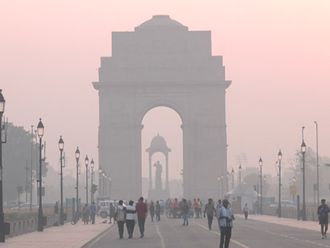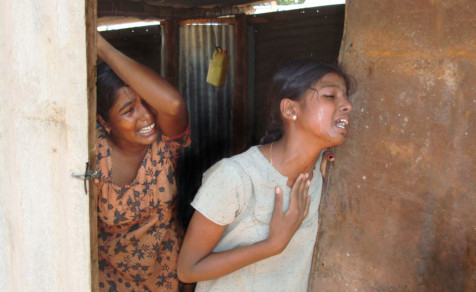
Callum Macrae’s documentary “No Fire Zone” is not a story, rather several stories strung together, of people like you and me, of families and children like yours and mine, who were rendered homeless during a 26-year-long civilian war. And what you see on screen are real, gory, bloody scenes.
Macrae’s earlier film, “Sri Lanka’s Killing Fields”, broadcast in June 2011 by the United Kingdom’s Channel 4, opened with the UN team leaving the island country in 2008, after the government expressed its inability to guarantee their safety while it pounded the Liberation Tigers of Tamil Eelam (LTTE) in Kilinochchi.
Gordon Weiss, UN spokesperson in Sri Lanka at that time and one of the interviewees in the film, says that the Lankan government regarded the UN presence an impediment to their conquest of Tamil Tigers and hence they did not want any international witnesses to their actions.
A UN official then captured images on his camera of several people who gathered at the gates of the UN office pleading with them to stay back and not leave. Once the UN was out of the scene, the government stepped up its attacks on civilians, both land and air.
People fled with their belongings and flocked to the No Fire Zone, created by the Lankan government with the promise of zero casualties. An abandoned primary school in Kilinochchi was turned into a makeshift hospital for displaced people. But this shelter, like many other hospitals of the No Fire Zone, became an easy target for the government’s indiscriminate shelling as revealed in the documentary.
Images of parents watching their children die for want of medical help roll on followed by one of another three young girls wailing over the death of their mother in an aerial shelling. You watch bodies of women being hauled on to a truck just like goods. Video footage show men stripped off their clothes and blindfolded with their hands tied behind, and then being popped off by soldiers.
According to the documentary around 40,000-70,000 people were killed in the few months prior to the end of war in 2009, not just by the government, but also by the LTTE who were using civilians as pawns and also shooting at civilians trying to escape to safety.
What is interesting about this documentary is that it comprised clippings caught on mobile cameras, of real situations, sometimes by the victims themselves and sometimes by the perpetrators of crime.
For instance a scene reveals a family huddled inside a trench and a woman screaming at the camera, “Why are you taking a video now? Come in and lie down. They are killing everyone?” A child’s wail rents the air.
One story that might haunt you is that of a 6-year-old boy who was severely injured on his left leg during an air raid and whose leg was literally cut off by a doctor at a hospital in Mullivayakkal.
Vani Kumar, a British Sri Lankan, was on a holiday in Sri Lanka in 2009 and he survived the war to share this tale with Macrae in this documentary. This biomedical research technician and a volunteer at Mullivayakkal hospital narrated: “I was asked to cover the boy’s mouth while another person held his hands and the doctor cut off his injured leg with a knife, the kind you use at home. The boy screamed in pain. I fainted. The doctor had to do that to save the boy’s life. I saw him alive later with an arm and a leg.”
“Sri Lanka’s Killing Fields” was nominated for the Bafta awards and Nobel Peace Prize in 2012 besides winning the Royal Television Society’s Television Journalism awards 2010/2011. (Check it out online at www.outsidertv.co.uk.)
Produced by ITN Productions this film was broadcast by Channel 4 News, exposing the gross violations of international and humanitarian laws by the Sri Lankan government and rebel LTTE forces. The documentary featured interviews with, among others, Benjamin Dix, a British UN worker based in Kilinochchi; William Schabas, an international human rights lawyer; and Steve Crawshaw of Amnesty International.
Although the images of this documentary were confirmed as authentic by the UN through forensic investigations, the Sri Lankan government refuted it as fake and staged.
Unfazed, filmmaker Callum Macrae is back with another documentary, “No Fire Zone”, an update on the massacre in Sri Lanka. And he is leaving no stone unturned in taking this gory picture world over.
To raise funds for this mission Macrae launched a campaign online this April 30 hoping to collect £20000 (Dh73,400). This target was reached within the first ten days and when the campaign ended on May 30 this year, a sum of £33768 was collected giving a lifeline to the mission.
Triggering interest in “No Fire Zone” is the picture of 12-year-old Balachandran Prabhakaran (son of LTTE supremo Prabhakaran) lying dead with five bullet injuries on his chest. It was recently published in leading dailies, including “The Hindu” in India.
In an e-mail interview, Macrae wrote, “The section on Prabhakaran’s son only takes a couple of minutes in a 93-minute film. But it has rightly grabbed headlines around the world. It is significant for a number of reasons. Partly because we now have photographic evidence which shows that this 12-year-old child was held in captivity, probably for a couple of hours or more, before he was executed. This evidence gives the lie to government claims that he could have been killed in crossfire, or as the government has also claimed that he was executed by his (own) bodyguards. This is a particularly silly claim as the footage shows the dead bodies of the men believed to be his bodyguards, who appear to have had their hands tied behind their backs when they were shot in the head.”
Macrae continued: “The footage also shows that this was a calm situation and there was no crossfire. In fact several soldiers are standing around, again raising serious questions about the command of an army in which this kind of act can apparently be carried out openly and with apparent impunity.
“But although there is a lot of evidence in the film about the war crimes committed in the last few days — such as the executions, sexual assaults and torture of prisoners — most of the evidence concerns the previous four months, in which perhaps 40,000 civilians — perhaps 70,000 or even more — were massacred, mostly by government shelling.”
Once again the clippings that came to Macrae were filmed by civilians and doctors at the relief camps, “some of it by Tamil Tiger camera operators who had originally expected to film the military exploits of the Tigers,” Macrae said, “but instead ended up filming the suffering of the civilians, a suffering which was caused mainly by government shelling and the denial of humanitarian aid such as food and medicines — but made worse by the Tigers themselves who were charged with preventing, and even shooting at, those who wished to escape the so-called no fire zones and take their chances with the government forces.”
Making this documentary was not easy, confessed Macrae, who grew up in Nigeria and Scotland. After studying painting at Edinburgh College of Arts for five years, he was a dustman for two years and had a short stint running a private radio station before becoming a teacher for seven years. He has won several awards, including the Royal Television Society award, Campaigning Journalist of the Year award and the Wincott Business Programme of the Year award.
“No Fire Zone is effectively the product of three years of investigation,” revealed this co-founder of Outsider TV. “It meant three years of watching some of the most terrible footage I have ever seen.”
However, this is not the first time that Macrae had to deal with painful and tragic situations in his journalistic career. His film, “The Final Betrayal”, is a documentary on northern Uganda where the much feared leader of Lord’s Resistance Army (LRA), Joseph Kony, abducted and trained children in brutality and to become his soldiers.
“I was taken to see what was supposed to be a victory against the LRA’s kidnapped child soldiers and young people, near the border with Sudan,” recalled Macrae. “I was told fifty rebels had been killed — but when we emerged from the bush the first dead ‘rebel’ I saw was no more than four. Beside him, also dead, lay a young girl, who may well have been his mother. You never forget sights like that.”
For his film “Sudan: War and Independence” made in 2011, he travelled secretly into South Kordofan, where he interviewed the rebel forces leader, Abdul Aziz Al Hilu.
Macrae’s film “On whose Order” was an investigation into the notorious Battle of Danny Boy, in Iraq, in 2004. It asked why five interrogation techniques banned for being inhuman in the 1970s were reintroduced by the British in Iraq.
Talking about another film, shot on location in the aftermath of the Japanese earthquake and tsunami, Macrae said, “The sight of a man — tiny in the distance — wheeling his bicycle across what was once a town but now reduced to a huge blasted mudflat near Sendai is hard to forget.”
So what gives him the strength to continue with this kind of work? “Of course it is true that you see some awful things in my job. However, I would say that curiously, you often come back with some bad images, but you also keep meeting people in these terrible situations who somehow manage to maintain their decency and their humanity. So it is not all awful.”
He added: “Sometimes it is quite inspiring. I suppose what keeps you from becoming too affected by the images is that you are always conscious that at least you only have to look at these scenes — the people in the images had to live through them. Also there is a sense in which as a filmmaker at least I am able to think I can do something about these crimes. I can help bring them to the world’s attention. In some ways that makes it easier.
“Strangely it is not the terrible sights of the dead and dying that haunt you. As humans we are quite good at distancing ourselves from their humanity. It is the survivors you cannot forget; the child who has lost a mother and the father who has lost his daughter.”
What about threats to his life? “Yes, sometimes you do stories which you know people in power will not like — and sometimes you worry for your own safety. But there are dangers too in crossing a busy road. All you can do is be careful and sensible.”
Mythily Ramachandran is a writer based in Chennai, India.


